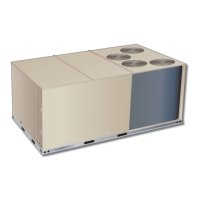Page 13
KHA180, 240
differences in installations. Significant differences
could mean that the system is not properly charged
or that a problem exists with some component in the
system. Correct any system problems before
proceeding.
6− If discharge pressure is high, remove refrigerant from
the system. If discharge pressure is low, add
refrigerant to the system.
Add or remove charge in increments.
Allow the system to stabilize each time
refrigerant is added or removed.
7− Use the following approach method along with the
normal operating pressures to confirm readings.
TABLE 3
KHA180 NORMAL OPERATING PRESSURES
Outdoor
Coil En-
tering
Air Temp
Circuit 1 Circuit 2
Dis. +10
psig
Suc. +5
psig
Dis. +10
psig
Suc. +5
psig
65F 270 138 270 135
75F 312 139 312 135
85F 356 142 356 136
95F 403 144 404 138
105F 455 147 458 140
115F 512 147 515 145
TABLE 4
KHA240 NORMAL OPERATING PRESSURES
Outdoor
Coil En-
tering
Air Temp
Circuit 1 Circuit 2
Dis. +10
psig
Suc. +5
psig
Dis. +10
psig
Suc. +5
psig
65F 275 135 278 135
75F 315 138 318 136
85F 359 140 364 138
95F 407 142 413 140
105F 457 144 466 141
115F 517 146 527 145
C−Charge Verification − Approach Method − AHRI Testing
1− Using the same thermometer, compare liquid
temperature to outdoor ambient temperature.
Approach Temperature = Liquid temperature (at
condenser outlet) minus ambient temperature.
2− Approach temperature should match values in table
5. An approach temperature greater than value
shown indicates an undercharge. An approach
temperature less than value shown indicates an
overcharge.
3− The approach method is not valid for grossly over or
undercharged systems. Use table 3 or 4 as a guide
for typical operating pressures.
TABLE 5
APPROACH TEMPERATURES
Unit
Liquid Temp. Minus Ambient Temp.
1st Stage 2nd Stage
180 & 240
12°F + 1
(6.7°C +
0.5)
12°F + 1
(6.7°C +
0.5)
D−Compressor Controls
1− High Pressure Switches (S4, S7)
Compressor circuits are protected by a high pressure
switch which cuts out at 640 psig +
10 psig (4413 kPa
+
70 kPa).
2− Freezestats (S49, S50)
Switches de−energize compressors when indoor coil
temperature falls below 29F (−2C) to prevent coil
freeze−up. Switches reset when indoor coil
temperature reaches 58F (15C).
3− Defrost Switches (S6, S9)
Defrost switches close to initiate defrost when liquid
line temperature falls to 35F (1.7C). The defrost
switch is located on the liquid line between the
outdoor expansion valve and the distributor
4− Defrost Termination Switches (S46, S104)
Defrost pressure switches open to terminate defrost
when vapor line (discharge pressure during cooling
and defrost) pressure reaches 450 psig (3103 kPa).
5− Defrost Controls (CMC1, CMC2)
Defrost is liquid line temperature initiated and
operates for 14 minutes unless terminated by vapor
line pressure drop.
When the liquid line temperature drops below 35°F,
the defrost switch closes and signals the defrost
control that a defrost cycle is needed. If the defrost
switch is still closed after 60 minutes (default), a
defrost cycle begins and operates for 14 minutes.
The defrost pressure switch can terminate the defrost
cycle before the 14 minutes elapses if vapor line
pressure reaches 450 +
10 psi.
6− Electric heat is energized during defrost to maintain
discharge air temperature.

